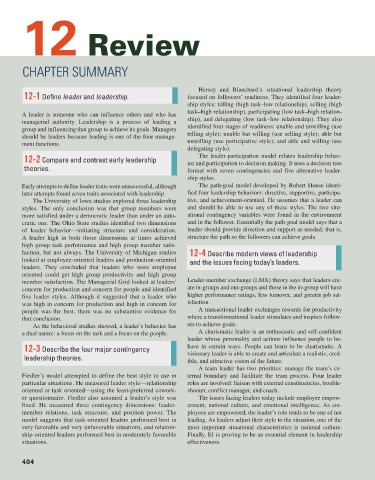Page 405 - Fundamentals of Management Myths Debunked (2017)_Flat
P. 405
12 Review
CHAPTER SUMMARy
Hersey and Blanchard’s situational leadership theory
12-1 Define leader and leadership. focused on followers’ readiness. They identified four leader-
ship styles: telling (high task–low relationship), selling (high
task–high relationship), participating (low task–high relation-
A leader is someone who can influence others and who has
managerial authority. Leadership is a process of leading a ship), and delegating (low task–low relationship). They also
group and influencing that group to achieve its goals. Managers identified four stages of readiness: unable and unwilling (use
should be leaders because leading is one of the four manage- telling style); unable but willing (use selling style); able but
ment functions. unwilling (use participative style); and able and willing (use
delegating style).
The leader-participation model relates leadership behav-
12-2 Compare and contrast early leadership ior and participation to decision making. It uses a decision tree
theories. format with seven contingencies and five alternative leader-
ship styles.
Early attempts to define leader traits were unsuccessful, although The path-goal model developed by Robert House identi-
later attempts found seven traits associated with leadership. fied four leadership behaviors: directive, supportive, participa-
The University of Iowa studies explored three leadership tive, and achievement-oriented. He assumes that a leader can
styles. The only conclusion was that group members were and should be able to use any of these styles. The two situ-
more satisfied under a democratic leader than under an auto- ational contingency variables were found in the environment
cratic one. The Ohio State studies identified two dimensions and in the follower. Essentially the path-goal model says that a
of leader behavior—initiating structure and consideration. leader should provide direction and support as needed; that is,
A leader high in both those dimensions at times achieved structure the path so the followers can achieve goals.
high group task performance and high group member satis-
faction, but not always. The University of Michigan studies 12-4 Describe modern views of leadership
looked at employee-oriented leaders and production-oriented and the issues facing today’s leaders.
leaders. They concluded that leaders who were employee
oriented could get high group productivity and high group
member satisfaction. The Managerial Grid looked at leaders’ Leader-member exchange (LMX) theory says that leaders cre-
concern for production and concern for people and identified ate in-groups and out-groups and those in the in-group will have
five leader styles. Although it suggested that a leader who higher performance ratings, less turnover, and greater job sat-
was high in concern for production and high in concern for isfaction.
people was the best, there was no substantive evidence for A transactional leader exchanges rewards for productivity
that conclusion. where a transformational leader stimulates and inspires follow-
As the behavioral studies showed, a leader’s behavior has ers to achieve goals.
a dual nature: a focus on the task and a focus on the people. A charismatic leader is an enthusiastic and self-confident
leader whose personality and actions influence people to be-
12-3 Describe the four major contingency have in certain ways. People can learn to be charismatic. A
visionary leader is able to create and articulate a realistic, cred-
leadership theories. ible, and attractive vision of the future.
A team leader has two priorities: manage the team’s ex-
Fiedler’s model attempted to define the best style to use in ternal boundary and facilitate the team process. Four leader
particular situations. He measured leader style—relationship roles are involved: liaison with external constituencies, trouble-
oriented or task oriented—using the least-preferred cowork- shooter, conflict manager, and coach.
er questionnaire. Fiedler also assumed a leader’s style was The issues facing leaders today include employee empow-
fixed. He measured three contingency dimensions: leader- erment, national culture, and emotional intelligence. As em-
member relations, task structure, and position power. The ployees are empowered, the leader’s role tends to be one of not
model suggests that task-oriented leaders performed best in leading. As leaders adjust their style to the situation, one of the
very favorable and very unfavorable situations, and relation- most important situational characteristics is national culture.
ship-oriented leaders performed best in moderately favorable Finally, EI is proving to be an essential element in leadership
situations. effectiveness.
404

